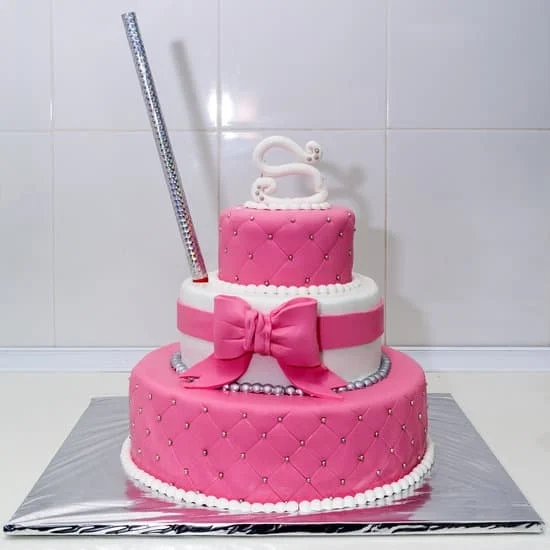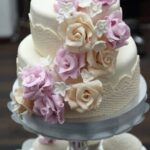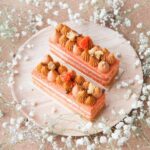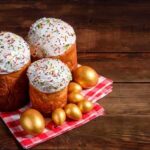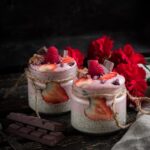Cake decorating is an art form that has captured the hearts and taste buds of people all over the world. The process of transforming a simple cake into a masterpiece through intricate designs and creative flair brings joy not only to the bakers but also to those fortunate enough to indulge in these edible works of art.
In recent years, cake decorating has seen a surge in popularity, with more and more individuals discovering the joy of creating visually stunning and delicious cakes. From birthdays to weddings, special occasions are now celebrated with beautifully decorated cakes that leave lasting impressions.
The appeal of cake decorating lies in its ability to engage both sight and taste. Not only do these creations captivate our eyes with their intricate details and vibrant colors, but they also delight our palates with their moistness, flavors, and textures. A well-textured cake is crucial for creating a solid foundation that can withstand the weight of various decorations while retaining its delectability.
So whether you are an experienced baker looking to expand your repertoire or someone eager to dip their toes into the world of cake decorating for the first time, it all begins with finding the perfect cake recipe. In the next sections, we will explore different cake recipes suitable for decorating and delve into essential techniques and tips for achieving professional-quality results.
Get ready to unleash your creativity as we embark on this delightful journey into the art of cake decorating.
The Importance of a Perfect Cake Recipe
A beautifully decorated cake can be a work of art, but the true foundation of any cake decoration is the recipe itself. The importance of a perfect cake recipe cannot be overstated, as it sets the stage for both the presentation and taste of the final product. A well-textured cake not only enhances the visual appeal of the decorations but also ensures a delicious and satisfying eating experience.
The Significance of Starting with a Delicious Cake Base
When it comes to cake decorating, attention to detail is key. Every element, from the color scheme to the intricate designs, contributes to creating a stunning visual masterpiece. However, what often gets overlooked is the role that the actual cake plays in this process. A perfectly baked cake provides a solid foundation for applying decorative elements such as frosting, fondant, or edible embellishments.
The texture and flavor of the cake are also vital in enhancing the overall taste experience. A moist and tender crumb adds to the enjoyment of each bite and ensures that all efforts put into decorating are worthwhile. On the other hand, a dense or dry cake can detract from even the most skillfully executed decorations. Therefore, investing time and effort into finding a perfect cake recipe is essential for achieving optimal results in cake decorating.
Finding the Right Cake Recipe for Decorating
When selecting a recipe specifically for decorating purposes, there are several factors to consider. One crucial aspect is choosing a flavor that complements your desired design and caters to personal preferences or dietary restrictions. Traditional favorites like vanilla and chocolate are versatile options that pair well with a wide range of decorations.
Texture is another critical consideration when choosing a recipe for decorating. For instance, an overly light and fluffy sponge may not provide enough stability to support heavy layers of fondant or intricate designs. Conversely, a dense pound cake may not allow for smooth edges or precise piping work. It is important to strike a balance between a cake that is moist and flavorful while still holding its shape and structure when adorned with decorative elements.
Experimenting with different recipes or adapting existing ones to suit your needs is encouraged. This can involve altering the ingredients, adjusting the baking time, or incorporating additional flavorings. The ultimate goal is to find a cake recipe that not only tastes delicious but also serves as the perfect canvas for your decorating dreams to come to life.
Choosing the Right Cake Recipe for Decorating
Choosing the right cake recipe for decorating is a crucial step in creating beautiful and delicious cakes. With so many options available, it can be overwhelming to know which recipe will yield the best results. In this section, we will briefly discuss various types of cake recipes suitable for decorating and highlight the key factors to consider when selecting a recipe.
Types of Cake Recipes
There are several types of cake recipes that work well for decorating, each with its own unique characteristics. Some popular choices include butter cakes, sponge cakes, and chiffon cakes. Butter cakes are known for their rich flavor and dense texture, making them ideal for sculpting and carving designs.
Sponge cakes have a light and airy texture, making them perfect for layered cakes that require a soft base. Chiffon cakes are incredibly moist and versatile, often used as a base for elaborate wedding cakes.
Factors to Consider
When choosing a cake recipe for decorating, there are several factors to consider to ensure the best outcome. One important factor is flavor – you want a cake that not only looks good but tastes good as well. Consider whether you want a classic vanilla or chocolate flavor or if you want to experiment with more unique flavors like red velvet or lemon.
Another critical factor is texture. A well-textured cake will provide the perfect canvas for your decorations. You’ll want a cake that is moist yet sturdy enough to support layers of frosting and decorative elements without crumbling or sagging.
Additionally, keep in mind any dietary restrictions or preferences your recipients may have. It’s important to have options available for those who may be gluten-free, dairy-free, or have other dietary restrictions.
By considering the type of cake and its characteristics such as flavor, texture, and dietary needs, you can choose the perfect recipe that will result in an exceptional decorated cake. Whether you opt for traditional flavors or venture into more unique combinations, selecting the right cake recipe will ensure that your decorative efforts shine through both in appearance and taste.
Classic Vanilla Cake Recipe for Decorating
A classic vanilla cake is a timeless choice for cake decorating. Its light and fluffy texture provides the perfect canvas for creative designs and intricate decorations. Below is a detailed recipe that will guide you in baking a delicious vanilla cake that is ideal for any occasion.
Ingredients:
- 2 ½ cups all-purpose flour.
- 2 ½ teaspoons baking powder.
- ½ teaspoon salt.
- 1 ½ cups granulated sugar.
- 1 cup unsalted butter, softened.
- 4 large eggs.
- 1 cup whole milk.
- 2 teaspoons vanilla extract.
Instructions:
- Step 1: Preheat your oven to 350°F (175°C). Grease and flour two round cake pans.
- Step 2: In a medium bowl, whisk together the flour, baking powder, and salt. Set aside.
- Step 3: In a separate large bowl, cream together the butter and sugar until light and fluffy. This can be done with an electric mixer on medium speed for about two minutes.
- Step 4: Beat in the eggs one at a time, ensuring each egg is fully incorporated before adding the next one. Add the vanilla extract and mix well.
- Step 5: Gradually add the dry ingredients into the wet mixture, alternating with the milk. Begin and end with the dry ingredients to ensure proper mixing. Mix until just combined, being careful not to overmix.
- Step 6: Divide the batter evenly between the prepared cake pans. Smooth out the tops using a spatula or the back of a spoon.
- Step 7: Bake in the preheated oven for approximately 25-30 minutes or until a toothpick inserted into the center of each cake comes out clean.
- Step 8: Remove from the oven and let cool in the pans for about ten minutes before transferring them to wire racks to cool completely.
Tips:
- For added flavor, you can scrape the seeds from a vanilla bean and add it to the batter.
- To ensure even baking, rotate the pans halfway through the baking time.
- Level off any rounded tops of the cakes before frosting for a more even decorating surface.
Now that you have a delectable vanilla cake as your base, it’s time to unleash your creativity and turn it into a masterpiece. Whether you choose to frost it with buttercream, cover it in fondant, or decorate it with intricate designs using royal icing, this classic vanilla cake will serve as the perfect foundation for your decorating adventures.
Decadent Chocolate Cake Recipe for Decorating
When it comes to cake decorating, a delicious and flavorful cake base is essential. While classic flavors like vanilla are always popular, there’s something irresistible about a rich and decadent chocolate cake. The deep, indulgent flavor of chocolate can elevate any cake design and leave your taste buds craving for more. In this section, we will explore a tantalizing chocolate cake recipe specifically tailored for decorating.
To create the perfect chocolate cake for decorating, it’s important to achieve the ideal balance between moistness and richness. Here’s a tried-and-true recipe that guarantees both:
Ingredients
- 2 cups all-purpose flour.
- 1 ¾ cups granulated sugar.
- ¾ cup unsweetened cocoa powder.
- 1 ½ teaspoons baking powder.
- 1 ½ teaspoons baking soda.
- 1 teaspoon salt.
- 2 large eggs.
- 1 cup whole milk.
- ½ cup vegetable oil.
- 2 teaspoons pure vanilla extract.
- 1 cup boiling water.
Instructions
- Preheat your oven to 350°F (176°C) Grease and flour two 9-inch round cake pans.
- In a large mixing bowl, whisk together the flour, sugar, cocoa powder, baking powder, baking soda, and salt until well combined.
- Add the eggs, milk, oil, and vanilla extract to the dry ingredients. Mix on medium speed for about two minutes until smooth.
- Reduce the mixer speed to low and gradually add the boiling water. Continue mixing until well incorporated.
- Pour the batter evenly into the prepared pans and bake in the preheated oven for approximately 30-35 minutes, or until a toothpick inserted into the center comes out clean.
- Remove the cakes from the oven and let them cool in the pans for about 10 minutes. Then, transfer them to a wire rack to cool completely before decorating.
To enhance the richness of your chocolate cake, consider adding a layer of ganache or frosting between the layers before applying your chosen decoration. The smooth and creamy texture of ganache perfectly complements the deep flavor of the chocolate cake.
Remember, when decorating your chocolate cake, be sure to consider color combinations and design elements that will beautifully showcase the richness of this delectable dessert. Whether it’s intricate piping or a simple garnish, let your creativity run wild with your finished masterpiece.
With this decadent chocolate cake recipe in hand, you are now ready to unleash your artistic skills and create stunning edible works of art. So gather your decorating tools and get ready to impress both visually and gastronomically with your indulgent chocolate creation.
Exploring Unique Flavors for Cake Decorating
Cake decorating has become increasingly popular, allowing bakers to unleash their creativity and transform a simple cake into a work of art. While classic flavors like vanilla and chocolate remain timeless choices for decorating, there is also a growing trend of using unique flavors to add excitement and novelty to cakes.
Whether it’s a red velvet cake with cream cheese frosting or a zesty lemon cake with lemon curd filling, these unconventional flavors can elevate the visual appeal and taste of decorated cakes.
One unique flavor that has gained popularity in recent years is red velvet. This vibrant and visually striking cake is often paired with cream cheese frosting, creating a beautiful contrast between the rich red color and the creamy white frosting. The addition of cocoa powder lends a subtle chocolate flavor to the cake, making it a delicious choice for both decorators and recipients.
For those looking for a refreshing twist, lemon cakes are an excellent option. Their bright citrusy flavor adds a burst of freshness to any cake design. Lemon cakes can be paired with various fillings such as lemon curd or raspberry preserves, adding layers of flavor that complement the tartness of the citrus. Finished with a light lemon buttercream frosting, these cakes are not only aesthetically pleasing but also incredibly delicious.
Another unique flavor that has gained popularity in recent years is salted caramel. This sweet and savory combination provides a delightful richness to decorated cakes. The caramel flavor can be incorporated into the cake itself through caramel syrup or added as part of an indulgent caramel buttercream frosting. Decorators can further enhance the taste by drizzling salted caramel sauce over the finished cake, creating an irresistible treat for both eyes and taste buds.
| Unique Flavor | Description |
|---|---|
| Red Velvet | A vibrant and visually striking cake with a subtle chocolate flavor, often paired with cream cheese frosting. |
| Lemon | A refreshing twist with a bright citrusy flavor, often accompanied by lemon curd filling and a light lemon buttercream frosting. |
| Salted Caramel | A sweet and savory combination that adds richness to decorated cakes, often incorporated into the cake itself or as part of a caramel buttercream frosting. |
Tips and Tricks for Decorating the Perfect Cake
Decorating a cake can be a fun and creative process, but it also requires some skill and technique to achieve a professional-looking result. In this section, we will explore some tips and tricks that will help you decorate the perfect cake.
One essential technique for cake decorating is leveling the cake layers. This ensures that each layer is even and flat, providing a stable foundation for your decorations. To level a cake, start by placing it on a flat surface and using a long serrated knife or a cake leveler to carefully slice off any domed or uneven parts. It’s important to keep the knife steady and maintain an even pressure while cutting to avoid tearing the cake.
Another important aspect of cake decorating is frosting. To achieve smooth and flawless frosting, it’s crucial to have the right consistency of icing. If the frosting is too stiff, it will be difficult to spread evenly on the cake surface. On the other hand, if it’s too runny, it won’t hold its shape well. The ideal consistency is when the frosting holds its form but still spreads easily.
To achieve this, start with a small amount of frosting and gradually add liquid (such as milk or water) if needed until you reach your desired consistency. Another tip is to always crumb coat your cakes before applying the final layer of frosting. A crumb coat is a thin layer of frosting that helps seal in any loose crumbs from the cake layers, preventing them from showing up on the final design.
When it comes to decorating techniques, there are various tools you can use to create different effects. Piping bags with different tips allow you to pipe intricate designs such as flowers or borders onto your cake. If you don’t have piping bags at hand, you can also use resealable plastic bags and snip off one corner for piping.
Additionally, using stencils or templates can help you create more precise designs on your cake. These can be easily made at home with cardstock or purchased from specialized cake decorating stores. Stencils are particularly useful for creating patterns or intricate designs on the cake surface.
Mastering the art of cake decorating takes practice, so don’t be discouraged if your first attempts don’t turn out as expected. As you continue to experiment and learn new techniques, you’ll find that your skills improve and your creativity flourishes. With these tips and tricks in mind, you’re well on your way to creating beautifully decorated cakes that are both delicious and visually stunning.
Adding Fondant and Other Decorative Elements
Cake decorating is not just about the taste of the cake, but also about the visual appeal. Adding fondant and other decorative elements can take a plain cake to the next level, transforming it into a work of art. Fondant is a smooth, pliable icing that can be rolled out and draped over cakes to create a flawless finish. It is often used for creating intricate designs, covering flaws, and adding vibrant colors to a cake.
To add fondant to your cake, you will need some essential tools such as a rolling pin, fondant smoother, and cornstarch or powdered sugar for dusting. Start by preparing your cake with a thin layer of buttercream frosting. This will help the fondant adhere to the cake and create a smooth surface. Knead your fondant until it becomes soft and pliable. Roll it out on a clean surface that has been lightly dusted with cornstarch or powdered sugar.
Once your fondant is rolled out to the desired thickness, carefully lift it onto your cake using a rolling pin as a guide. Gently press the fondant onto the sides of the cake, smoothing out any air bubbles or wrinkles with a fondant smoother. Trim off any excess fondant using a sharp knife or pizza cutter.
Now comes the fun part – decorating your fondant-covered cake. You can use additional pieces of colored fondant to create designs such as flowers, bows, or even characters. These decorations can be made in advance and attached to the cake using water or edible glue.
In addition to fondant, there are many other decorative elements you can use to enhance your cake’s appearance. Edible pearls, glitter dust, edible flowers, chocolate shavings, and fresh fruit are just some examples of popular decorative options. The key is to experiment with different combinations and techniques to create unique designs that suit your style.
| Tools | Materials |
|---|---|
| Rolling pin | Fondant |
| Fondant smoother | Buttercream frosting |
| Knife or pizza cutter | Cornstarch or powdered sugar (for dusting) |
| – | Additional colored fondant for decorations |
| – | Edible pearls, glitter dust, edible flowers, chocolate shavings, fresh fruit (optional) |
Remember, practice makes perfect when it comes to working with fondant and decorations. Don’t be afraid to make mistakes and try new techniques. With some patience and creativity, you can create stunning masterpieces that will impress both your eyes and taste buds. So go ahead and unleash your inner artist in cake decorating.
Showcasing Beautifully Decorated Cakes
One of the most exciting aspects of cake decorating is the opportunity to create stunning and visually appealing designs. From elegant wedding cakes to whimsical birthday creations, beautifully decorated cakes are a feast for the eyes. In this section, we will explore some inspiring examples of various decorated cakes using different techniques.
First, let’s take a look at a classic buttercream masterpiece. This three-tiered cake features smooth, flawless frosting in pastel hues, adorned with delicate floral piping. The intricate details bring sophistication to the design while still maintaining an airy and light feel. This type of cake is perfect for weddings or formal events.
For those looking for a more playful approach, a fondant-covered cake can be a delightful choice. Imagine a two-tiered cake covered in vibrant pink fondant with delicate sugar flowers cascading down one side. This whimsical creation would be perfect for a child’s birthday party or any occasion that calls for a touch of fun.
If you have a flair for artistic expression, consider trying your hand at painting on cakes. Using edible paints and brushes, you can create stunning works of art directly on your cake canvas. Imagine an intricately painted watercolor design adorning the sides of a naked cake or delicate hand-painted flowers gracefully dancing across an elegant white frosted cake.
Whether you prefer sleek and sophisticated designs or whimsical and playful creations, there is no shortage of inspiration when it comes to beautifully decorated cakes. The possibilities are endless, limited only by your creativity and imagination. With practice and patience, you too can create show-stopping cakes that not only taste delicious but also leave everyone in awe of your talent.
Conclusion
In conclusion, cake decorating is a delightful art that has gained immense popularity in recent years. The joy it brings to both bakers and recipients is undeniable. However, the foundation for a beautifully decorated cake lies in the perfect cake recipe. Starting with a delicious and well-textured cake base enhances not only the visual presentation but also the overall taste of the finished product.
When choosing a cake recipe for decorating, there are several factors to consider. The flavor and texture of the cake play crucial roles in determining its suitability for decorating purposes. For instance, a classic vanilla cake recipe provides a versatile canvas for various designs and flavors, while a decadent chocolate cake adds richness and indulgence.
Additionally, exploring unique flavors can elevate your cake decorating game by adding an unexpected twist to traditional recipes. Whether it’s red velvet, lemon, or salted caramel, using unconventional flavors allows you to unleash your creativity and create cakes that are both visually stunning and incredibly delicious.
To achieve professional-looking results, mastering essential techniques such as leveling and frosting is essential. These skills ensure that your cake has an even surface for decorating and that the frosting provides a smooth backdrop for any decorative elements you add.
Furthermore, fondant is a popular choice for adding intricate details to decorated cakes. Learning how to apply fondant properly opens up endless possibilities for creative designs. By following step-by-step instructions and experimenting with different techniques, you can create show-stopping cakes that are almost too beautiful to eat.
Frequently Asked Questions
What kind of cake is easiest to decorate?
The kind of cake that is easiest to decorate would be a simple single-layer cake with a smooth surface. This could be a basic vanilla or chocolate cake, without any intricate designs or decorations already present.
A flat surface makes it much easier to apply frosting and other decorations evenly, ensuring a clean and polished look. Additionally, cakes that have cooled completely before decorating are also easier to work with, as they are less likely to crumble or break while being handled.
What are the ingredients used in decorating cake?
There are various ingredients used in decorating cakes, depending on the desired design and technique being employed. One of the most common ingredients is frosting or icing, which can be buttercream, royal icing, fondant, ganache, or cream cheese frosting.
Frosting acts as the base for decorating and helps to hold other decorative elements in place. Other common ingredients used for decoration include food coloring for tinting frostings and creating vibrant designs, sprinkles for adding texture and color, edible flowers or fruit for garnishing, and various piping tools like pastry bags and tips for creating intricate designs.
How do you prepare a cake before decorating?
Before decorating a cake, it is important to properly prepare it to ensure the best results. Firstly, the cake should be completely cooled after baking before starting the decoration process. This allows for easier handling without breaking or crumbling. Next, it is recommended to level the top of the cake if necessary by using a serrated knife so that it sits flat on a serving platter or stand.
If desired, some bakers like to brush their cakes with simple syrup flavored with extracts (such as lemon or vanilla) to add moisture and enhance the flavor profile before applying decorations. Finally, it’s essential to make sure any crumbs or loose debris is removed from the cake’s surface by gently brushing it off or using a crumb coat – a thin layer of frosting applied all over the cake that helps trap loose crumbs before adding additional layers of frosting for decoration purposes. Once these steps are completed, the cake is ready to be decorated.

Welcome to our cake decorating blog! My name is Destiny Flores, and I am the proud owner of a cake decorating business named Cake Karma. Our mission is to provide delicious, beautiful cakes for all occasions. We specialize in creating custom cakes that are tailored specifically to each customer’s individual needs and tastes.

